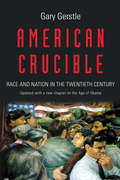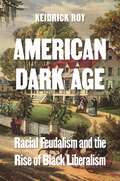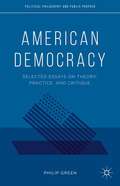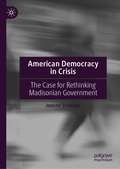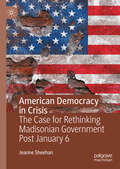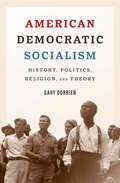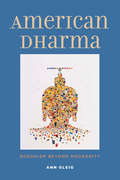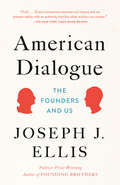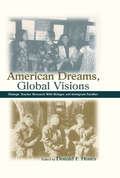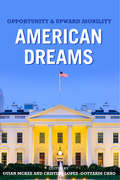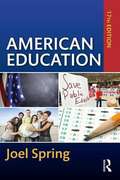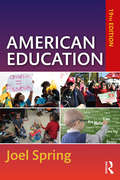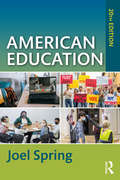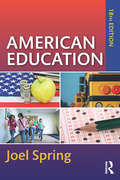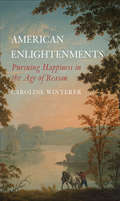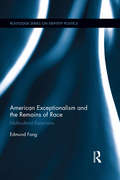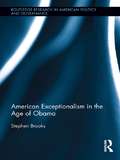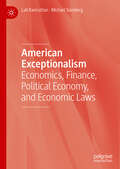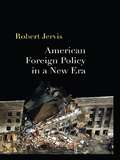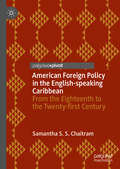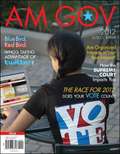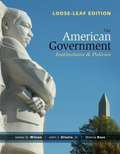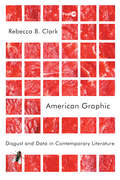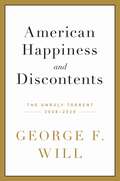- Table View
- List View
American Crucible: Race and Nation in the Twentieth Century
by Gary GerstleThis sweeping history of twentieth-century America follows the changing and often conflicting ideas about the fundamental nature of American society: Is the United States a social melting pot, as our civic creed warrants, or is full citizenship somehow reserved for those who are white and of the "right" ancestry? Gary Gerstle traces the forces of civic and racial nationalism, arguing that both profoundly shaped our society. After Theodore Roosevelt led his Rough Riders to victory during the Spanish American War, he boasted of the diversity of his men's origins- from the Kentucky backwoods to the Irish, Italian, and Jewish neighborhoods of northeastern cities. Roosevelt’s vision of a hybrid and superior “American race,” strengthened by war, would inspire the social, diplomatic, and economic policies of American liberals for decades. And yet, for all of its appeal to the civic principles of inclusion, this liberal legacy was grounded in “Anglo-Saxon” culture, making it difficult in particular for Jews and Italians and especially for Asians and African Americans to gain acceptance. Gerstle weaves a compelling story of events, institutions, and ideas that played on perceptions of ethnic/racial difference, from the world wars and the labor movement to the New Deal and Hollywood to the Cold War and the civil rights movement. We witness the remnants of racial thinking among such liberals as FDR and LBJ; we see how Italians and Jews from Frank Capra to the creators of Superman perpetuated the New Deal philosophy while suppressing their own ethnicity; we feel the frustrations of African-American servicemen denied the opportunity to fight for their country and the moral outrage of more recent black activists, including Martin Luther King, Jr., Fannie Lou Hamer, and Malcolm X. Gerstle argues that the civil rights movement and Vietnam broke the liberal nation apart, and his analysis of this upheaval leads him to assess Reagan’s and Clinton’s attempts to resurrect nationalism. Can the United States ever live up to its civic creed? For anyone who views racism as an aberration from the liberal premises of the republic, this book is must reading.Containing a new chapter that reconstructs and dissects the major struggles over race and nation in an era defined by the War on Terror and by the presidency of Barack Obama, American Crucible is a must-read for anyone who views racism as an aberration from the liberal premises of the republic.
American Dark Age: Racial Feudalism and the Rise of Black Liberalism
by Keidrick RoyHow medieval-inspired racial feudalism reigned in early America and was challenged by Black liberal thinkersThough the United States has been heralded as a beacon of democracy, many nineteenth-century Americans viewed their nation through the prism of the Old World. What they saw was a racially stratified country that reflected not the ideals of a modern republic but rather the remnants of feudalism. American Dark Age reveals how defenders of racial hierarchy embraced America&’s resemblance to medieval Europe and tells the stories of the abolitionists who exposed it as a glaring blemish on the national conscience.Against those seeking to maintain what Frederick Douglass called an &“aristocracy of the skin,&” Keidrick Roy shows how a group of Black thinkers, including Frances Ellen Watkins Harper, Hosea Easton, and Harriet Jacobs, challenged the medievalism in their midst—and transformed the nation&’s founding liberal tradition. He demonstrates how they drew on spiritual insight, Enlightenment thought, and a homegrown political philosophy that gave expression to their experiences at the bottom of the American social order. Roy sheds new light on how Black abolitionist writers and activists worked to eradicate the pernicious ideology of racial feudalism from American liberalism and renew the country&’s commitment to values such as individual liberty, social progress, and egalitarianism.American Dark Age reveals how the antebellum Black liberal tradition holds vital lessons for us today as hate groups continue to align themselves with fantasies of a medieval past and openly call for a return of all-powerful monarchs, aristocrats, and nobles who rule by virtue of their race.
American Democracy
by Philip GreenThe book examines the problems that plague contemporary American democracy. Written from the standpoint of democratic theory, and from a progressive point of view, the book explores different facets of American democratic culture and its various deficits deficits that can lead to the crippling of democratic politics. "
American Democracy in Crisis: The Case for Rethinking Madisonian Government
by Jeanne SheehanPublic disenchantment with and distrust of American government is at an all-time high and who can blame them? In the face of widespread challenges—everything from record levels of personal and national debt and the sky high cost of education, to gun violence, racial discrimination, an immigration crisis, overpriced pharmaceuticals, and much more—the government seems paralyzed and unable to act, the most recent example being Covid-19. It’s the deadliest pandemic in over a century. In addition to an unimaginable sick and death toll, it has left more than thirty million Americans unemployed. Despite this, Washington let the first round of supplemental unemployment benefits run out and for more than a month were unable to agree on a bill to help those suffering. This book explains why we are in this situation, why the government is unable to respond to key challenges, and what we can do to right the ship. It requires that readers “upstream,” stop blaming the individuals in office and instead look at the root cause of the problem. The real culprit is the system; it was designed to protect liberty and structured accordingly. As a result, however, it has left us with a government that is not responsive, largely unaccountable, and often ineffective. This is not an accident; it is by design. Changing the way our government operates requires rethinking its primary goal(s) and then restructuring to meet them. To this end, this book offers specific reform proposals to restructure the government and in the process make it more accountable, effective, and responsive.
American Democracy in Crisis: The Case for Rethinking Madisonian Government Post January 6
by Jeanne SheehanThis book analyzes the roots of widespread disenchantment with American government. While blame often falls on the individuals in office, they are not operating in isolation. Rather they are working within a system designed by the Framers with one goal in mind, protectionism. Although the Framers got much right, their commitment to protection of liberty led them to design a system replete with divisions of power. Whatever its merits at the founding, the government today is frequently described as dysfunctional and far too often unresponsive to the majority, unaccountable, and unable to deliver for its people. For those disillusioned with the current state of government and committed to effectuating meaningful change, this book advocates in favor of a fundamental reassessment of the system's primary objectives, followed by deliberation as to how it should be restructured accordingly. It not only presents specific reform proposals, but it ends with a stark warning: until and unless we embrace reasoned structural reform, we cannot be surprised if at some point the people become so frustrated that they either disengage, fight back, or seek solace in autocratic alternatives. This new edition includes audiobook files created by a state of the art text-to-speech tool at the chapter level.
American Democratic Socialism: History, Politics, Religion, and Theory
by Gary DorrienA sweeping, ambitious history of American democratic socialism from one of the world&’s leading intellectual historians and social ethicists &“Dorrien is supremely qualified for the task he has set himself in this very thoughtful, necessary, and timely book.&”—Maurice Isserman, author of The Other American: The Life of Michael Harrington Democratic socialism is ascending in the United States as a consequence of a widespread recognition that global capitalism works only for a minority and is harming the planet&’s ecology. This history of American democratic socialism from its beginning to the present day interprets the efforts of American socialists to address and transform multiple intersecting sites of injustice and harm. Comprehensive, deeply researched, and highly original, this book offers a luminous synthesis of secular and religious socialisms, detailing both their intellectual and their organizational histories.
American Dharma: Buddhism Beyond Modernity
by Ann GleigThe past couple of decades have witnessed Buddhist communities both continuing the modernization of Buddhism and questioning some of its limitations. In this fascinating portrait of a rapidly changing religious landscape, Ann Gleig illuminates the aspirations and struggles of younger North American Buddhists during a period she identifies as a distinct stage in the assimilation of Buddhism to the West. She observes both the emergence of new innovative forms of deinstitutionalized Buddhism that blur the boundaries between the religious and secular, and a revalorization of traditional elements of Buddhism such as ethics and community that were discarded in the modernization process. Based on extensive ethnographic and textual research, the book ranges from mindfulness debates in the Vipassana network to the sex scandals in American Zen, while exploring issues around racial diversity and social justice, the impact of new technologies, and generational differences between baby boomer, Gen X, and millennial teachers.
American Dialogue: The Founders and Us
by Joseph J. EllisThe award-winning author of Founding Brothers and The Quartet now gives us a deeply insightful examination of the relevance of the views of George Washington, Thomas Jefferson, James Madison, and John Adams to some of the most divisive issues in America today. <p><p> The story of history is a ceaseless conversation between past and present, and in American Dialogue Joseph J. Ellis focuses the conversation on the often-asked question "What would the Founding Fathers think?" He examines four of our most seminal historical figures through the prism of particular topics, using the perspective of the present to shed light on their views and, in turn, to make clear how their now centuries-old ideas illuminate the disturbing impasse of today's political conflicts. He discusses Jefferson and the issue of racism, Adams and the specter of economic inequality, Washington and American imperialism, Madison and the doctrine of original intent. Through these juxtapositions--and in his hallmark dramatic and compelling narrative voice--Ellis illuminates the obstacles and pitfalls paralyzing contemporary discussions of these fundamentally important issues.
American Dreams, Global Visions: Dialogic Teacher Research With Refugee and Immigrant Families (Sociocultural, Political, and Historical Studies in Education)
by Donald F. HonesThis book presents the struggle for dialogue and understanding between teachers and refugee and immigrant families, in their own words. Forging a stronger connection between teachers, newcomers, and their families is one of the greatest challenges facing schools in the United States. Teachers need to become familiar with the political, economic, and sociocultural contexts of these newcomers' lives, and the role of the U.S. in influencing these contexts in positive and negative ways. The important contribution of American Dreams, Global Visions is to bring together global issues of international politics and economics and their effects on migration and refugee situations, national issues of language and social policy, and local issues of education and finding ways to live together in an increasingly diverse society. Narratives of four immigrant families in the United States (Hmong, Mexican, Assyrian/Kurdish, Kosovar) and the teacher-researchers who are coming to know them form the heart of this work. The narratives are interwoven with data from the research and critical analysis of how the narratives reflect and embody local, national, and global contexts of power. The themes that are developed set the stage for critical dialogues about culture, language, history, and power. Central to the book is a rationale and methodology for teachers to conduct dialogic research with refugees and immigrants--research encompassing methods as once ethnographic, participatory, and narrative--which seeks to engage researchers and participants in dialogues that shed light on economic, political, social, and cultural relationships; to represent these relationships in texts; and to extend these dialogues to promote broader understanding and social justice in schools and communities. American Dreams, Global Visions will interest teachers, social workers, and others who work with immigrants and refugees; researchers, professionals, and students across the fields of education, language and culture, ethnic studies, American studies, and anthropology; and members of the general public interested in learning more about America's most recent newcomers. It is particularly appropriate for courses in foundations of education, multicultural education, comparative education, language and culture, and qualitative research.
American Dreams: Opportunity and Upward Mobility (Miller Center Studies on the Presidency)
by Peter Wehner Michael Nelson William A. Galston Margaret O'Mara Richard Schragger Melody Barnes Cristina Lopez-Gottardi Chao Guian McKee Robert C. PiantaIn an increasingly polarized political environment, the first year of the new president’s term will be especially challenging. With a fresh mandate, however, the first year also offers opportunities that may never come again. The First Year Project is a fascinating initiative by the Miller Center of the University of Virginia that brings together top scholars on the American presidency and experienced officials to explore the first twelve months of past administrations, and draw practical lessons from that history, as we inaugurate a new president in January 2017.This project is the basis for a new series of digital shorts published as Miller Center Studies on the Presidency. Presented as specially priced collections published exclusively in an ebook format, these timely examinations recognize the experiences of past presidents as an invaluable resource that can edify and instruct the incoming president.Contributors: Melody Barnes, New York University * William A. Galston, Brookings Institution * Dambisa Moyo, global economist and author * Michael Nelson, Rhodes College * Margaret O’Mara, University of Washington * Robert Pianta, University of Virginia * Richard Schragger, University of Virginia * Peter Wehner, Ethics and Public Policy Center
American Education
by Joel SpringJoel Spring's American Education introduces readers to the historical, political, social, and legal foundations of education and to the profession of teaching in the United States. In his signature straightforward and concise approach to describing complex issues, Spring illuminates events and topics and that are often overlooked or whitewashed, giving students the opportunity to engage in critical thinking about education. In this edition he looks closely at the global context of education in the U.S. Featuring current information and challenging perspectives--with scholarship that is often cited as a primary source, students will come away from this clear, authoritative text informed on the latest topics, issues, and data and with a strong knowledge of the forces shaping of the American educational system. Changes in the 17th Edition include new and updated material and statistics on economic theories related to "skills" education and employability the conflict between a skills approach and cultural diversity political differences regarding education among the Republican, Democratic, Libertarian and Green parties social mobility and equality of opportunity as related to schooling global migration and student diversity in US schools charter schools and home schooling
American Education (Sociocultural, Political, and Historical Studies in Education)
by Joel SpringFeaturing current information and challenging perspectives on the latest issues and forces shaping the American educational system—with scholarship that is often cited as a primary source—Joel Spring introduces readers to the historical, political, social, and legal foundations of education and to the profession of teaching in the United States. In his signature straightforward, concise approach to describing complex issues, he illuminates events and topics that are often overlooked or whitewashed, giving students the opportunity to engage in critical thinking about education. Students come away informed on the latest topics, issues, and data and with a strong knowledge of the forces shaping the American educational system. Thoroughly updated throughout, the new edition of this clear, authoritative text remains fresh and up-to-date, reflecting the many changes in education that have occurred since the publication of the previous edition. Topics and issues addressed and analyzed include: • The decline of the Common Core State Standards, particularly as result of a Republican-controlled administration currently in place• Increasing emphasis on for-profit education, vouchers, charter schools, and free-market competition between schools, expected to surge with the appointment of the new U.S. Secretary of Education Betsy DeVos • Current debates about immigration and "Dreamers"—new statistics on immigrant education, discussion of education proposals to accommodate the languages, cultures, and religions of newly arrived immigrants• New education statistics on school enrollments, dropouts, education and income, school segregation, charter schools, and home languages• The purposes of education as presented in the 2016 platforms of the Republican, Democratic, Green, and Libertarian parties• Discussions around transgender students
American Education (Sociocultural, Political, and Historical Studies in Education)
by Joel SpringFeaturing current information and challenging perspectives on the latest issues and forces shaping the American educational system—with scholarship that is often cited as a primary source—Joel Spring introduces readers to the historical, political, social and legal foundations of education and to the profession of teaching in the United States. In his signature straightforward, concise approach to describing complex issues, he illuminates events and topics that are often overlooked or whitewashed, giving students the opportunity to engage in critical thinking about education. Students come away informed on the latest topics, issues and data and with a strong knowledge of the forces shaping the American educational system. Thoroughly updated throughout, the 20th edition of this clear, authoritative text remains fresh and up to date, reflecting the many changes in education that have occurred since the publication of the previous edition, such as: The effects of the pandemic on schools, teachers, students, learning and social goals The latest U.S. Department of Education guidelines for school prayer, regulations on sexual harassment and Title IX and guidelines for writing IEPs Expanded discussion of institutional racism Coverage relating to transgender youth and athletics
American Education (Sociocultural, Political, and Historical Studies in Education)
by Joel SpringFeaturing current information and challenging perspectives on the latest issues and forces shaping the American educational system—with scholarship that is often cited as a primary source—Joel Spring introduces readers to the historical, political, social and legal foundations of education and to the profession of teaching in the United States. In his signature straightforward, concise approach to describing complex issues, he illuminates events and topics that are often overlooked or whitewashed, giving students the opportunity to engage in critical thinking about education. Students come away informed on the latest topics, issues and data and with a strong knowledge of the forces shaping the American educational system. Updated throughout, the 21st edition of this clear, authoritative text remains fresh and up-to-date, reflecting the many changes in education that have occurred since the publication of the previous edition. New coverage includes: Discussion of “culture wars” and critical race theory Parental rights versus the goals of common education LGBTQIA+ students’ rights Discussion of the current administration’s educational policies
American Education: From The Puritans To The Trump Era (Sociocultural, Political, and Historical Studies in Education)
by Joel SpringFeaturing current information and challenging perspectives on the latest issues and forces shaping the American educational system—with scholarship that is often cited as a primary source, Joel Spring introduces readers to the historical, political, social, and legal foundations of education and to the profession of teaching in the United States. In his signature straightforward, concise approach to describing complex issues, he illuminates events and topics that are often overlooked or whitewashed, giving students the opportunity to engage in critical thinking about education. Students come away informed on the latest topics, issues, and data and with a strong knowledge of the forces shaping the American educational system. Thoroughly updated throughout, the 18th edition of this clear, authoritative text remains fresh and up to date, reflecting the many changes in education that have occurred since the publication of the previous edition. Topics and issues addressed and analyzed include • The decline of the Common Core State Standards, particularly as result of a Republican-controlled administration currently in place • Increasing emphasis on for-profit education, vouchers, charter schools and free-market competition between schools, expected to surge with the appointment of the new U.S. Secretary of Education Betsy DeVos • Current debates about immigration and "Dreamers"—new statistics on immigrant education, discussion of education proposals to accommodate the languages, cultures and religions of newly arrived immigrants • New education statistics on school enrollments, dropouts, education and income, school segregation, charter schools and home languages • The purposes of education as presented in the 2016 platforms of the Republican, Democratic, Green, and Libertarian parties • Discussions around transgender students
American Enlightenments: Pursuing Happiness in the Age of Reason
by Caroline WintererA provocative reassessment of the concept of an American golden age of European-born reason and intellectual curiosity in the years following the Revolutionary War The accepted myth of the "American Enlightenment" suggests that the rejection of monarchy and establishment of a new republic in the United States in the eighteenth century was the realization of utopian philosophies born in the intellectual salons of Europe and radiating outward to the New World. In this revelatory work, Stanford historian Caroline Winterer argues that a national mythology of a unitary, patriotic era of enlightenment in America was created during the Cold War to act as a shield against the threat of totalitarianism, and that Americans followed many paths toward political, religious, scientific, and artistic enlightenment in the 1700s that were influenced by European models in more complex ways than commonly thought. Winterer's book strips away our modern inventions of the American national past, exploring which of our ideas and ideals are truly rooted in the eighteenth century and which are inventions and mystifications of more recent times.
American Exceptionalism and the Remains of Race: Multicultural Exorcisms (Routledge Series on Identity Politics #10)
by Edmund FongIn contemporary American political culture, claims of American exceptionalism and anxieties over its prospects have resurged as an overarching theme in national political discourse. Yet never very far from such debates lie animating fears associated with race. Fears about the loss of national unity and trust often draw attention to looming changes in the racial demographics of the body politic. Lost amid these debates are often the more complex legacies of racial hybridity. Anxieties over the disintegration of the fabric of American national identity likewise forget not just how they echo past fears of subversive racial and cultural difference, but also exorcise as well the changing nature of work and social interaction. Edmund Fong’s book examines the rise and resurgence of contemporary forms of American exceptionalism as they have emerged out of contentious debates over cultural pluralism and multicultural diversity in the past two decades. For a brief time, serious considerations of the force of multiculturalism entered into a variety of philosophical and policy debates. But in the American context, these debates often led to a reaffirmation of some variant of American exceptionalism with the consequent exorcism of race within the avowed norms and policy goals of American politics. Fong explores how this "multicultural exorcism" revitalizing American exceptionalism is not simply a novel feature of our contemporary political moment, but is instead a recurrent dynamic across the history of American political discourse. By situating contemporary discourse on cultural pluralism within the larger frame of American history, this book yields insight into the production of hegemonic forms of American exceptionalism and how race continues to haunt the contours of American national identity.
American Exceptionalism in the Age of Obama (Routledge Research in American Politics and Governance)
by Stephen BrooksThe election of President Obama in 2008 and the apparent decline of American power in the world has rekindled an old and important debate. Is the United States exceptional in its values and institutions, as well as in the role that it is destined to play in world affairs? In this book, Stephen Brooks argues that American exceptionalism has been and continues to be real. In making this argument he focuses on five aspects of American politics and society that are most crucial to an understanding of American exceptionalism today. They include the appropriate relationship between the state and citizens, religion, socio-economic mobility, America’s role in the world, and ideas about the Constitution. American exceptionalism matters in domestic politics chiefly as a political narrative around which support for and opposition to certain policies, values and vision of American society coalesce. But in world affairs it is not the story but the empirical reality of American exceptionalism that matters. Although the long era of America’s global economic dominance has entered what might be called a period of diminished expectations, the United States remains exceptional—the indispensable nation—in world affairs and is likely to remain so for many years to come.
American Exceptionalism: Economics, Finance, Political Economy, and Economic Laws
by Michael Szenberg Lall RamrattanThe publication of Alexis de Tocqueville’s Democracy in America has kindled interest across disciplines to appraise the exceptional nature of U.S. activities. In general, however, all the published works have not focused their analyses from an economic point of view. While economics was for some a “dismal science” following Thomas Carlyle’s characterization of Malthus’ demographic model, it has increasingly become the “queen of the social sciences” for more practitioners. The book fills a gap in the literature by describing the American contributors as precursors and genuinely exceptional economists. We present their works within the state of the nation in which they advance their discipline.One is treated to both qualitative and quantitative theories in the opening chapter. Budding theories that became established theories of Economics and Finance are investigated in Chapters II and III. When President John Adams was confronted with M. Turgot’s criticisms of the American government, he resorted to a historic survey of types of government from ancient Greece to the Middle Ages. Similarly, we have included a final chapter, Chapter IV, to present the argument for American Exceptionalism in the domain of Political Economy and Economic Law over the ages.
American Foreign Policy in a New Era
by Robert JervisTo say that the world changed drastically on 9/11 has become a truism and even a cliché. But the incontestable fact is that a new era for both the world and US foreign policy began on that infamous day and the ramifications for international politics have been monumental.In this book, one of the leading thinkers in international relations, Robert Jervis, provides us with several snapshots of world politics over the past few years. Jervis brings his acute analysis of international politics to bear on several recent developments that have transformed international politics and American foreign policy including the War on Terrorism; the Bush Doctrine and its policies of preventive war and unilateral action; and the promotion of democracy in the Middle East (including the Iraq War) and around the world. Taken together, Jervis argues, these policies constitute a blueprint for American hegemony, if not American empire. All of these events and policies have taken place against a backdrop equally important, but less frequently discussed: the fact that most developed nations, states that have been bitter rivals, now constitute a "security community" within which war is unthinkable.American Foreign Policy in a New Era is a must read for anyone interested in understanding the policies and events that have shaped and are shaping US foreign policy in a rapidly changing and still very dangerous world.
American Foreign Policy in the English-speaking Caribbean: From the Eighteenth to the Twenty-first Century
by Samantha S. ChaitramThis book traces American engagement in the English-speaking Caribbean from the eighteenth to the twenty-first century, and is the first to examine the policies of Presidents George W. Bush, Barack Obama and Donald Trump in this context. Focusing on The Bahamas, Jamaica, Trinidad and Tobago and Guyana as case studies, the book describes the growth of the English-speaking Caribbean and highlights American interest and foreign relations in this region from European discovery up through the post-9/11 era to today (1492-2019). The book demonstrates the unique relationship between America and the former British colonies, shedding light on U.S. foreign policy with the Caribbean in general and at a bilateral level with the four selected countries, providing a useful survey for students, scholars, diplomats, policymakers, governments officials, and anyone interested in gaining a better understanding of U.S. – Caribbean relations.
American Government 2012
by McGraw-HillPublished annually at the start of each year,Am Govprovides unmatched currency and is the first student-centered American Government text. It provides instructors who normally choose a big, brief, or essentials text with scholarly, succinct, and conventionally organized core content. A magazine format engages students and motivates active participation in our democracy (all this, and at a price that students prefer). Painstaking student and instructor reviews, surveys, and focus groups; as well as ethnographic research into student study behaviors, preferences, and needs, makeAm Govthe product of serious scholarship. Am Govbrings serious fun to American Government through its quality, currency, features, and format.
American Government: Institutions And Policies
by James Q. Wilson John J. Diiulio Meena BoseAcclaimed for the scholarship of its prominent authors and the clarity of its narrative, AMERICAN GOVERNMENT: INSTITUTIONS AND POLICIES sets the standard for public policy coverage while maintaining focus on three fundamental topics: the institutions of American government; the historical development of governmental procedures, actors, and policies; and who governs in the United States and to what ends. Reader involvement in the material is bolstered by features such as learning objectives, Constitutional Connections relating current issues to founding principles, and How Things Work boxes that illustrate important concepts. Available separately, a state-of-the-art media package with online tools makes the learning experience engaging and accessible.
American Graphic: Disgust and Data in Contemporary Literature (Post*45)
by Rebecca B. ClarkWhat do we really mean when we call something "graphic"? In American Graphic, Rebecca Clark examines the "graphic" as a term tellingly at odds with itself. On the one hand, it seems to evoke the grotesque; on the other hand, it promises the geometrically streamlined in the form of graphs, diagrams, and user interfaces. Clark's innovation is to ask what happens when the same moment in a work of literature is graphic in both ways at once. Her answer suggests the graphic turn in contemporary literature is intimately implicated in the fraught dynamics of identification. As Clark reveals, this double graphic indexes the unseemliness of a lust—in our current culture of information—for cool epistemological mastery over the bodies of others. Clark analyzes the contemporary graphic along three specific axes: the ethnographic, the pornographic, and the infographic. In each chapter, Clark's explication of the double graphic reads a canonical author against literary, visual and/or performance works by Black and/or female creators. Pairing works by Edgar Allan Poe, Vladimir Nabokov, and Thomas Pynchon with pieces by Mat Johnson, Kara Walker, Fran Ross, Narcissister, and Teju Cole, Clark tests the effects and affects of the double graphic across racialized and gendered axes of differences. American Graphic forces us to face how closely and uncomfortably yoked together disgust and data have become in our increasingly graph-ick world.
American Happiness and Discontents: The Unruly Torrent, 2008-2020
by George F. WillExamine the ways in which expertise, reason, and manners are continually under attack in our institutions, courts, political arenas, and social venues with this collection from the Pulitzer Prize-winning conservative columnist. George F. Will has been one of this country&’s leading columnists since 1974. He won the Pulitzer Prize for it in 1977. The Wall Street Journal once called him &“perhaps the most powerful journalist in America.&” In this new collection, he examines a remarkably unsettling thirteen years in our nation&’s experience, from 2008 to 2020. Included are a number of columns about court cases, mostly from the Supreme Court, that illuminate why the composition of the federal judiciary has become such a contentious subject. Other topics addressed include the American Revolutionary War, historical figures from Frederick Douglass to JFK, as well as a scathing assessment of how State of the Union Addresses are delivered in the modern day. Mr. Will also offers his perspective on American socialists, anti-capitalist conservatives, drug policy, the criminal justice system, climatology, the Coronavirus, the First Amendment, parenting, meritocracy and education, China, fascism, authoritarianism, Frank Sinatra, Bob Dylan, The Beach Boys, and the morality of enjoying football. American Happiness and Discontents: The Unruly Torrent, 2008-2020 is a collection packed with wisdom and leavened by humor from one the preeminent columnists and intellectuals of our time.
